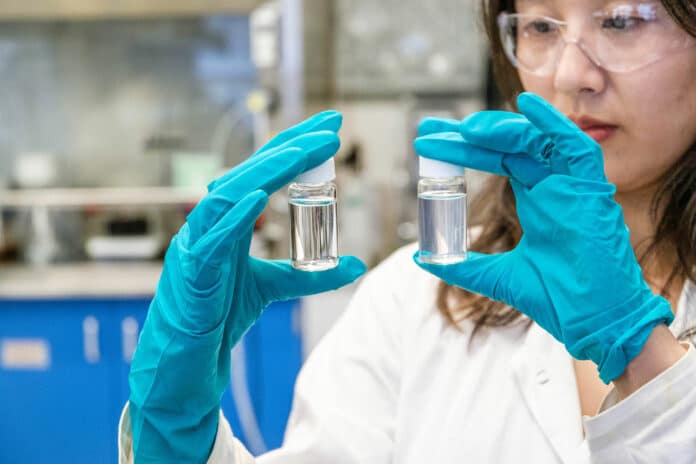Nano- or microplastics (NMPs) are a growing concern, both for human health and the environment, due to their widespread distribution and potential harmfulness. Keeping these tiny pieces of plastic debris out of water supplies is a huge challenge.
Now, researchers from the University of British Columbia (UBC) in Canada may have found a simple, effective, green solution to remove virtually all microplastic particles present in water by using readily available plant materials. Their method, they’re calling “bioCap,” trapped up to 99.9% of plastic particles in a column of water.
Unlike plastic filters, the new device does not contribute to further pollution as it uses renewable and biodegradable materials: tannic acids from plants, bark, wood and leaves, and wood sawdust – a forestry byproduct that is both widely available and renewable.
The bioCap exploits the properties of wood residues (sawdust) and natural polyphenols, which generate strong and multiple molecular interactions with a broad spectrum of nano-/microplastics. To create their bioCap, researchers used the wood sawdust as a hierarchical substrate containing aligned assemblies of cellulosic fibers combined with hemicelluloses and lignin, which facilitate efficient water transport.
The wood sawdust was sourced from a furniture factory and modified with a tannic acid – a naturally occurring plant polyphenol found in almost all plants without underground root systems.
In order to test bioCap’s ability to capture microplastics, the researchers pumped a water stream rich in NMPs through the column containing the filter. Particularly, bioCap is tested with NMPs that are most commonly detected in the environment, including polystyrene (PS), polymethyl methacrylate (PMMA), polypropylene (PP), polyvinyl chloride (PVC), polyethylene terephthalate (PET), and polyethylene (PE).
Scanning electron microscopy (SEM) analyses confirmed the capture of NMPs through bioCap, with no noticeable change to the structure of the sawdust with the added layer of tannic acid. The bioCap filtering system removed from 95.2% to as much as 99.9% of plastic particles in a column of water, depending on the plastic type.
However, the removal efficiency of unmodified sawdust was significantly low – less than 10%, demonstrating that the polyphenol was key to microplastic adsorption and capture.
“There are microfibres from clothing, microbeads from cleansers and soaps, and foams and pellets from utensils, containers, and packaging,” said Dr. Orlando Rojas, a professor in the departments of wood science, chemical and biological engineering, and chemistry at UBC. “By taking advantage of the different molecular interactions around tannic acids, our bioCap solution was able to remove virtually all of these different microplastic types.”
Microplastics with a smaller size (110 nm) have a higher surface area and a higher probability of penetrating the blood-to-brain barrier, thereby accumulating in organs and imposing more risks to human health. Therefore, researchers investigated the capability of bioCap to remove NMPs of smaller sizes (110 nm). Two groups of mice (three in each group) were fed either bioCap-treated purified or untreated drinking water for one week, and their organs were examined using an in vivo imaging system (IVIS). It showed that the bioCap-filtered water resulted in fewer NMP accumulations in organs.
While the experiment remains a lab set-up at this stage, the researchers say their solution can be scaled up easily and inexpensively once they find the right industry partner.
“Most solutions proposed so far are costly or difficult to scale up,” Dr. Rojas said in a statement. “We’re proposing a solution that could potentially be scaled down for home use or scaled up for municipal treatment systems.”
Journal reference:
- Yu Wang, Mengyue Wang, Qin Wang, Taoyang Wang, Zhengming Zhou, Marina Mehling, Tianyu Guo, Hang Zou, Xiao Xiao, Yunxiang He, Xiaoling Wang, Orlando J. Rojas, Junling Guo. Flowthrough Capture of Microplastics through Polyphenol-Mediated Interfacial Interactions on Wood Sawdust. Advanced Materials, 2023; DOI: 10.1002/adma.202301531
